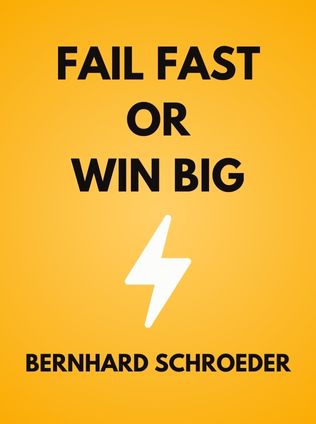
Fail Fast or Win Big
The Start-Up Plan for Starting Now
By Bernhard Schroeder
Published 02/2015
About the Author
Bernhard Schroeder, an influential figure in the field of entrepreneurship, is well-known for his role as the Director at the Lavin Entrepreneurship Center at San Diego State University. His career is marked by extensive experience in marketing and brand strategy, having worked with Fortune 100 companies including Apple, Nike, and Mercedes Benz. Schroeder's unique insights are drawn from his time as a Senior Partner at CKS Partners, where he helped shape the strategies of major corporations. His work focuses on guiding startups through the complexities of the modern business landscape, emphasizing agility, customer understanding, and innovative thinking.
Main Idea
"Fail Fast or Win Big" challenges the conventional wisdom surrounding business planning and startup development. Schroeder introduces the LeanModel Framework™, a methodology designed to replace the traditional, often cumbersome business planning process. The main idea is to emphasize speed and flexibility, allowing entrepreneurs to test their ideas quickly and adjust based on real-world feedback. This approach is particularly relevant in today’s rapidly changing markets, where the ability to adapt can be the difference between success and failure. Schroeder's framework consists of four main components: Lean Resources, Business Model, Rapid Prototyping, and Customer Truth. Each component plays a crucial role in helping entrepreneurs bring their ideas to market efficiently and effectively.
Table of Contents
- Introduction to the LeanModel Framework
- The End of Business Plans
- Rapid Prototyping
- Understanding Customer Truth
- The Role of Crowdfunding
- Identifying Market Opportunities
- Building a Resilient Team
- Entrepreneurship as a Mindset
- Conclusion: The Journey of Entrepreneurship
Introduction to the LeanModel Framework
The LeanModel Framework™ is Schroeder’s innovative approach to launching startups. It replaces the traditional business plan with a more dynamic and adaptable model. The framework's four components are designed to help entrepreneurs navigate the complexities of starting a business in a fast-paced environment.
Lean Resources: Schroeder advocates for a minimalist approach, where entrepreneurs use only the resources absolutely necessary. This mentality helps startups remain agile and reduces initial overhead costs. By focusing on lean operations, startups can quickly adapt to market changes without being bogged down by unnecessary expenses. For example, instead of investing heavily in office space, a startup might choose to work remotely or in shared workspaces until revenue streams are more stable.
Business Model: Developing a sound business model is crucial. Schroeder emphasizes the need to thoroughly understand the market, current trends, and the target customer segment. A business model should not only make sense but also be profitable. This involves identifying a unique value proposition, understanding customer segments, and devising effective distribution strategies. For instance, a startup targeting millennials might focus on digital marketing channels and e-commerce platforms, reflecting the shopping habits of this demographic.
Rapid Prototyping: This component involves creating a minimum viable product (MVP) quickly and testing it in the market. The goal is to gather customer feedback as soon as possible, allowing the startup to make necessary adjustments. This iterative process helps refine the product and aligns it more closely with customer needs. For example, a tech startup might release a beta version of its app to a small group of users to test its features and usability before a full launch.
Customer Truth: Understanding the real needs and desires of customers is essential. Schroeder advises entrepreneurs to engage directly with their target audience, using methods like surveys, interviews, and market observations. This component ensures that the product or service developed truly meets the market's demands, increasing the chances of success. He states:
"Listening to and gathering feedback from your potential customers is crucial. Feedback from customers is what will often give you the insight needed to iterate, pivot, or abandon your idea." - Bernhard Schroeder
The End of Business Plans
In this section, Schroeder critiques the traditional business planning process, which he believes is too slow and inflexible for the modern entrepreneurial landscape. The traditional model, which emphasizes detailed business plans and extensive market research, often leads to delays and missed opportunities. Schroeder argues that the pace of market changes today makes long-term planning less effective. He highlights several issues with the traditional approach:
Sign up for FREE and get access to 1,400+ books summaries.
You May Also Like
The Lean Startup
How Today's Entrepreneurs Use Continuous Innovation to Create Radically Successful Businesses
By Eric RiesWho Moved My Cheese?
An Amazing Way to Deal with Change in Your Work and in Your Life
By Spencer Johnson, M.D.Make Your Bed
Little Things That Can Change Your Life...And Maybe the World
By William H. McRavenThe Ride of a Lifetime
Lessons Learned from 15 Years as CEO of the Walt Disney Company
By Robert Iger



















